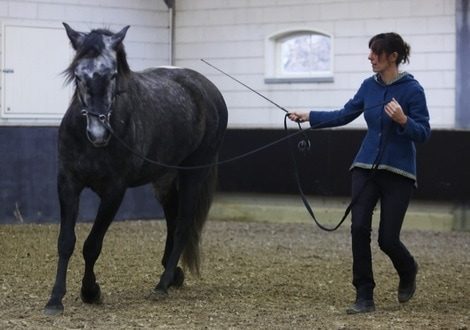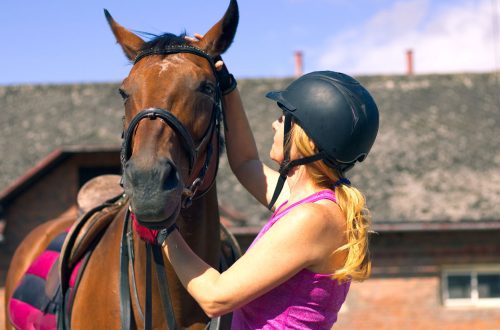
Seven secrets of horse care
Seven secrets of horse care
You have probably noticed that the result of the horse cleaning procedure is that the cleaner your horse becomes, the dirtier you become. There is no ready-made recipe for getting a horse in order in a couple of minutes, but you can optimize your task if you approach it wisely.
In this article, you will find some tips to help you take care of your horse like a pro.
Secret number 1. Shiny wool
If you want sparkle and shine, get yourself a good rubber comb. It removes deep-seated dirt, promotes blood circulation and helps distribute natural oils throughout the horse’s coat. In addition, cleaning with a rubber comb becomes a kind of mini-massage for your horse.
Rubber combs are rigid and flexible. Choose the one that suits your horse best.
Start brushing your horse by making small, circular motions over his body. Then take a medium bristled brush and work it in short, quick strokes against the coat. This will remove the dirt and loose hairs that you previously lifted with the comb. Finish with a soft brush that will buff the coat to a shine.
A hair care spray will not replace a groomer and a brush, but it will undoubtedly add shine. The spray allows not only to add the finishing touch to the image of the horse before the start, but also (with its regular use) significantly reduce the cleaning time. Using the spray 1-2 times a week, you can prevent the appearance of spots on light horses, in addition, thanks to the spray, dust does not linger on the horses.
Note that it is advisable to avoid spraying the saddle area as it makes the coat smooth and slippery, which can cause the gear to slip.
The truly healthy sheen of a horse’s coat, however, depends not only on quality care, but also on nutrition. If you are concerned about the quality of your horse’s coat, discuss it with your veterinarian to make sure your horse’s diet is optimal. You may need skin and coat health supplements (they combine essential ingredients including fats, vitamins and biotin to promote coat growth and luster). You can also add some vegetable oil to your horse’s feed, gradually increasing the dosage to 1 cup. This will positively affect the shine and make the color of the horse’s coat brighter and more saturated. During the molting season, a decoction of flaxseed can be very useful for horses.
Secret number 2. Dealing with tangled mane and tail
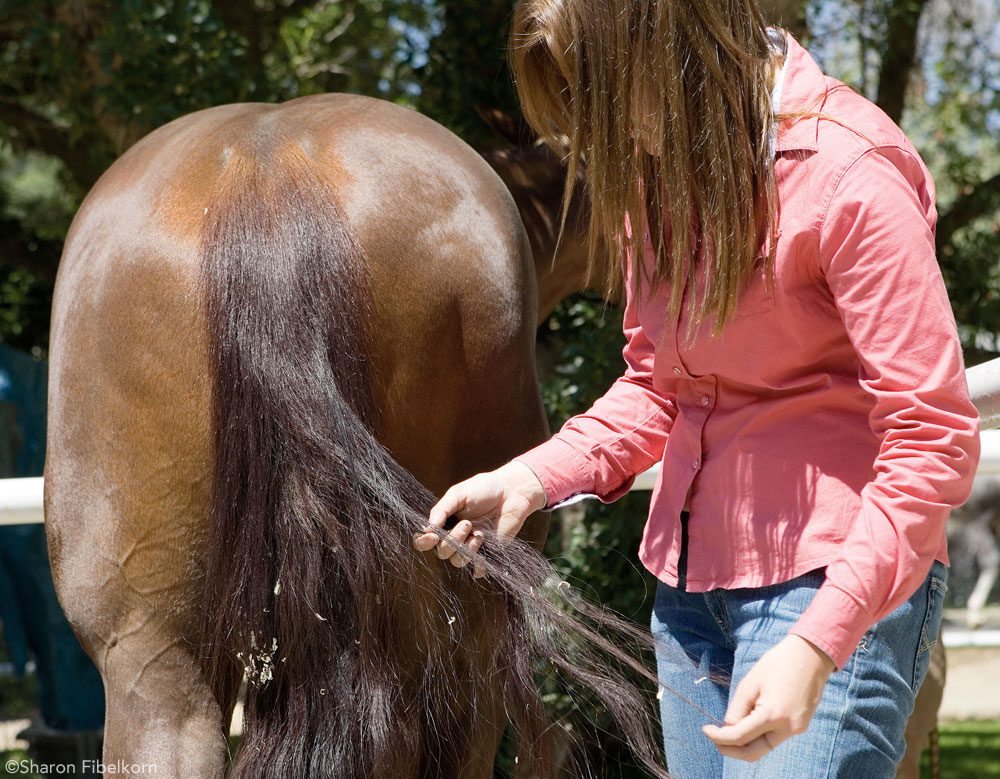
The best way to untangle the tail and mane is to do it by hand, although you can also use a wide-toothed plastic comb. A special spray for the mane and tail will greatly facilitate your work. The hairs will become more slippery and will not get tangled. Many sprays, among other things, add volume to the mane and tail.
Spray evenly over mane or tail. Then start taking them apart in small bunches, from bottom to top. To remove stubborn dirt or loosen up tangled knots, apply the mane and tail spray directly to the problem area.
Once you can easily run your fingers through the tail or mane, a comb or brush can be used if desired. Many people think that cleaning the tail is not good. But there is another point of view: brushing helps to stimulate blood circulation at the hair roots, thereby promoting their growth. If you choose to brush, choose a wide brush with wide-spaced bristles that are soft at the ends. Hold a bunch of hair in one hand, twist it and work your way up from the bottom.
Secret number 3. Long mane and tail
If you want your horse to have a long, beautiful mane and tail, your goal is to minimize hair loss and fight brittle ends. Avoid excessive brushing. The less you process your hair, the more valuable strands you will save.
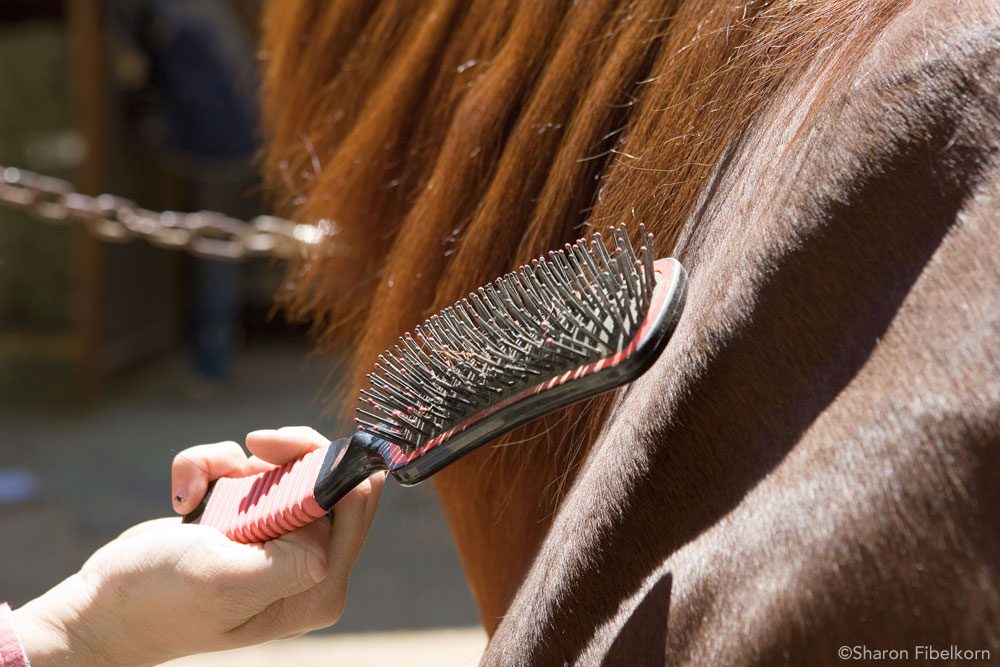
Choose a comb or brush with soft, wide-spaced bristles that won’t damage your hair.
Remove debris from the mane and tail daily, such as sawdust and hay. You can do this by hand, with your fingers, or by shaking the tail or mane quickly and sharply. Regular detangling will prevent the formation of large tangles and facilitate care.
Keeping the mane and tail clean also promotes hair growth. Shampoo the mane and tail once a week if possible to remove dirt from the root zone. Remember to rinse thoroughly.
Condition your hair, focusing on the ends. Let your hair dry completely before brushing or braiding.
To protect your long, thick mane from debris and tangles, braid it in thick braids. The braids should not be tight at the base, otherwise they will itch and the horse will start combing them against fences, stall walls, etc. If necessary, or once a week after bathing, twist the braids. A long mane requires regular grooming, but the results can be spectacular.
Secret number 4. Awesome tail
The length and thickness of your horse’s tail is largely a matter of genetic predisposition, but we can help your horse achieve its “tail potential” a little.
A popular tail grooming technique is braiding or using a special protective bag. This helps to avoid the appearance of tangles and pollution. Braid a thick, not tight braid below the rib. A bag for the tail is attached to the braid. Never tie the bag to the neck – this can disrupt blood circulation. Remember that during the high season, braiding or bagging your horse’s tail reduces its ability to protect itself from flies and other insects. For horses kept on pasture, this becomes a greater problem than for those who live in stalls.
A horse that rubs its tail against walls and other surfaces, pulling out and combing out its hair, is a sadness for any horse owner. Possible reasons for this are dry, itchy skin; parasites (pinworms); an allergic reaction caused by hypersensitivity to insects. Soothing shampoo, targeted deworming, and taking steps to control insects are easy solutions to start with. Skin problems and allergies will require consultation with a veterinarian – he will advise the necessary treatment.
Note that a dirty anus and/or udder can be the reason a horse scratches its tail (horses cannot scratch these places).
Secret number 5. Eliminate unwanted hair
Trim the long hairs under the horse’s chin, the brushes on the legs, and the hair sticking out of the ears to give it a more groomed look.
For this simple job, a small trimmer with a #10 blade will suffice. Before you start, make sure that your horse perceives it normally (sound, touch). You will need to work in the direction of hair growth so that you cut only the longest hairs. If you move the trimmer against the growth of the hair, you will get a shorter “haircut”.
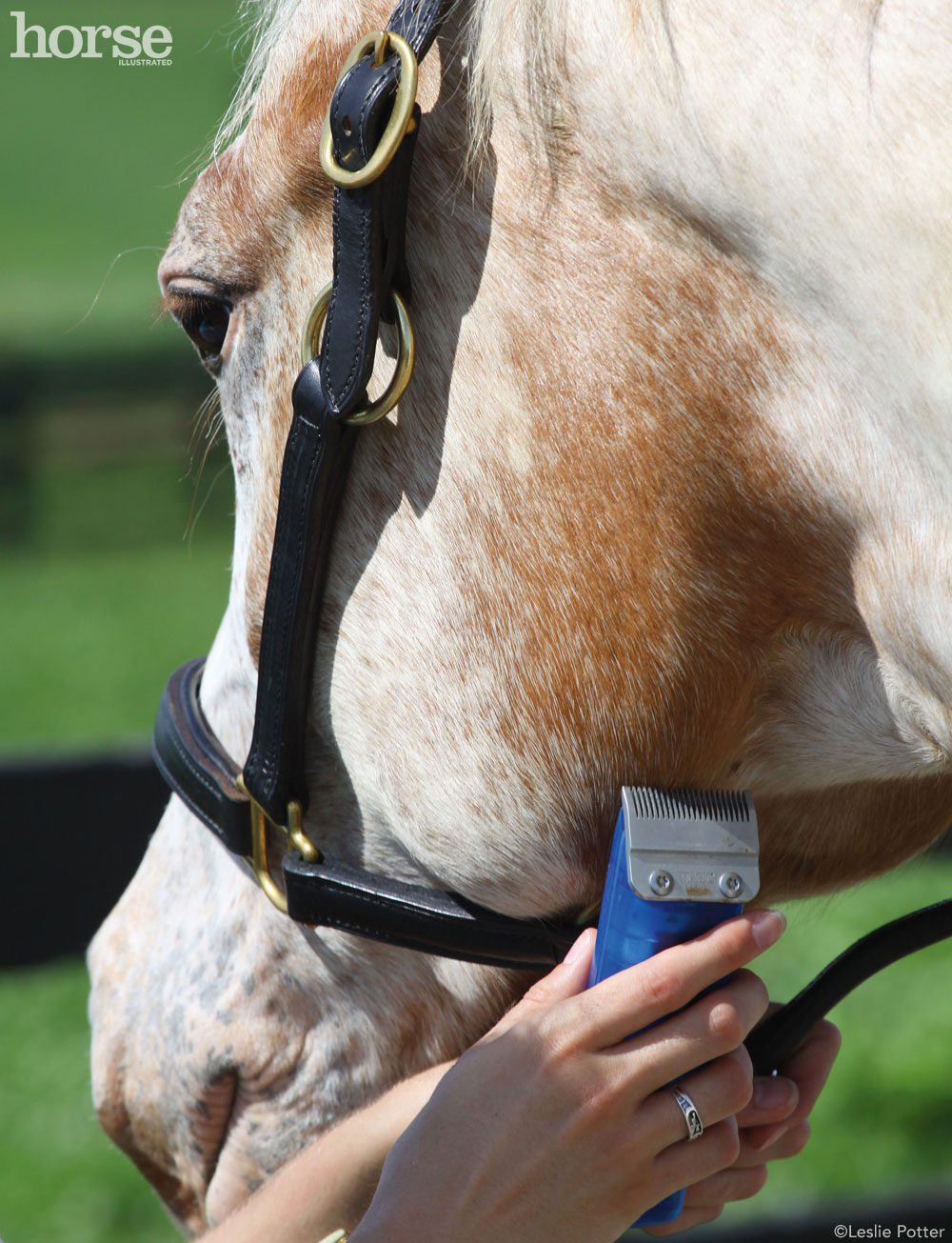
Trim the long hair along your horse’s chin, lining it up with the hairs on the edges.
To trim the “goatee”, work the trimmer at the angle of hair growth. Try to even out the length of the hair to create a clear outline of the jaw.
Trim long hairs on the back of your legs by turning the trimmer in the direction of hair growth. Unfold it to shave the brushes well.
Ear hair provides protection from bugs and mosquitoes in the summer and helps keep the horse warm in the winter, so it’s best not to remove too much hair if your horse is grazing.
Hold the ear in one hand, gently fold it lengthwise so that the edges touch, and use the trimmer to trim any excess hair that protrudes beyond the edge of the ear. This will align the hair inside the ear along the outer edge.
A neater look can be given to a horse by removing a small tuft of mane behind its ears, where the nape strap lies. You can use either a trimmer or small scissors. Be careful not to get carried away and remove too much mane down the neck. The width of the treated area should be equal to the width of two fingers, so that the occipital strap of the bridle fits easily there.
The vibrissae on the muzzle have a sensory function, which is why many horse owners choose to keep these little “whiskers”. Those who find them looking untidy remove them. If the horse is going to a tournament, check if you can remove vibrissae, if this is against the rules. In our opinion, the best solution is to leave them in place.
Secret number 6. Bathing
Bath procedures should be comfortable for the horse. Warm water will please the horse and also open up the pores of the skin so you can clean them more effectively. The adjustable sprinkler will help you adjust the water flow so that it doesn’t bother your horse.
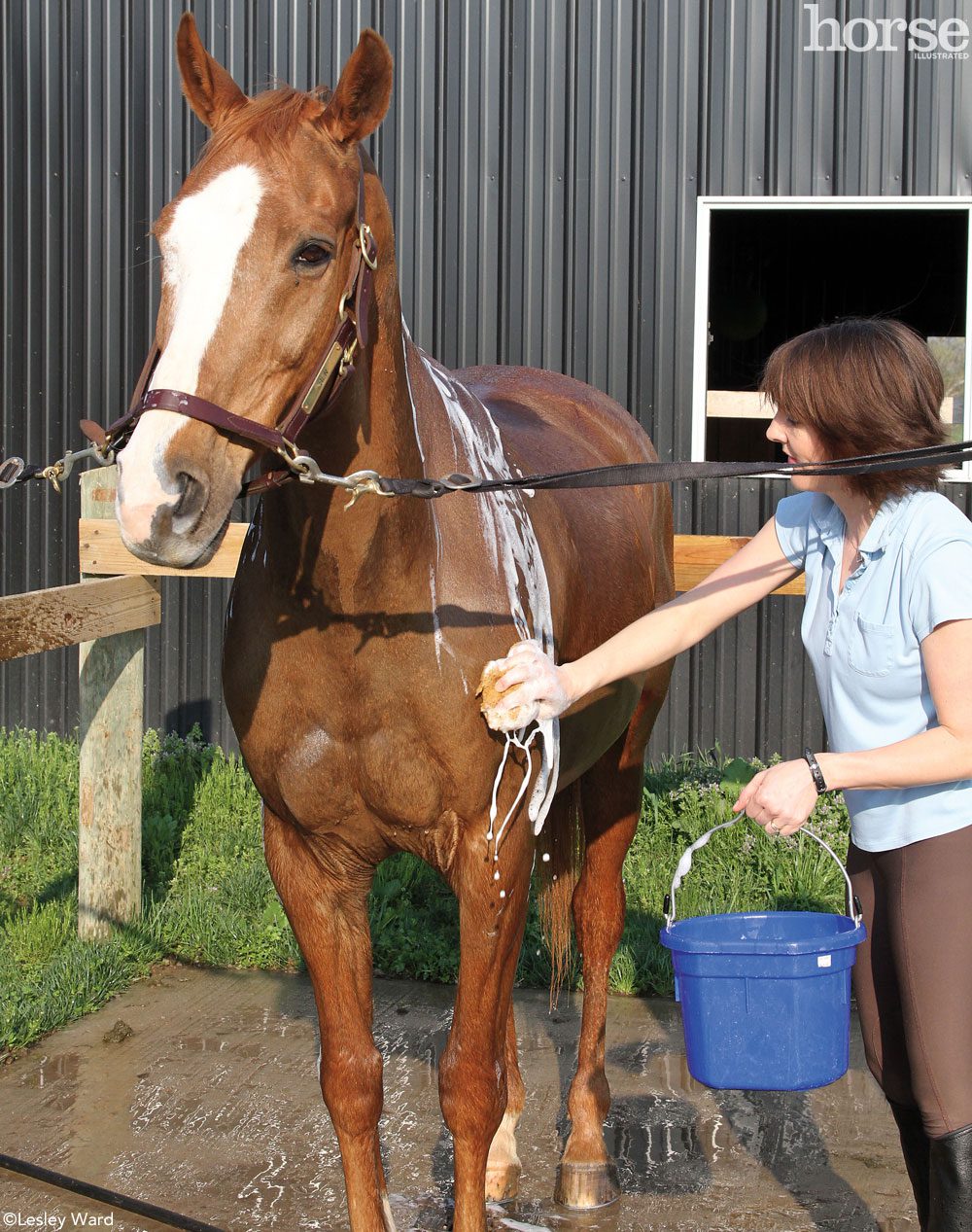
If you dilute the shampoo in a bucket of water, it will make things easier for you. Some equine shampoos are concentrated and are meant to be diluted before use (read the instructions ahead of time).
Keep in mind that more shampoo does not necessarily result in a cleaner horse. Start with a small amount and build up more lather as needed. Use a washing mitt to better clean the horse’s skin, or try it with your fingers. You can shampoo directly on the mane and tail.
There is usually no need to use shampoo on the muzzle and head of the horse. In addition, we note that it can be difficult to wash off the foam from these places. A damp towel or sponge will suffice. If the horse has a blaze or white hair on its head, dip a sponge into the diluted shampoo and gently rinse off the lather.
When bathing a horse, never use laundry soap, dishwashing liquid, or other strong detergents. They will irritate the skin and wash the natural oils out of the coat.
Equine shampoos and conditioners have the right pH level and are good at removing tough dirt.
It is very important to rinse the foam and soap well. Soap left on the coat dries it out, can cause itching and dandruff, and the horse’s coat will be dull instead of shiny. To make sure there is no soap left on the horse’s coat, use a water scraper to remove excess water. If you see soap bubbles, rinse the wool again. Repeat the process until the water runs clear.
Keep the horse out in the sun and don’t let him off the lead or line until he’s dry. If you take a wet horse to his stall or paddock, the first thing he will want to do is to wallow in the dust and mud, which will negate your efforts. To prevent stains from sticking to the horse so much and to add extra shine to his coat, spray on wet coat.
Horses do not need frequent bathing with shampoo. In most cases, dirt and sweat can be removed with plain water. If you bathe your horse often, use a mild horse shampoo and condition your horse’s coat. Conditioners strengthen the hairs, restore moisture and smooth the coat, which enhances its shine.
Secret number 7. “Winter whiteness”
Keeping a “white” horse’s coat really white is no easy task. White socks and markings also require extra effort or they will turn yellow.
Brush your horse regularly – this way you will not let the stains grow “tightly”. When bathing is not possible, use dry shampoos and stain removers. Spray on and wipe the stain with a towel if you can’t bathe your horse. You can also wash the stain with a sponge and dry it with a cloth.
The specially formulated whitening shampoo will be your best friend. Read the instructions carefully. Some bleaching shampoos need to be left on the coat and not rinsed off. Some, if used too often, in too large amounts, or left unwashed, may leave a purple tint. Use shampoo strictly according to the instructions.
“Stubborn” spots on the tail may require several sessions of bleaching shampoo. If your horse turns purple, don’t panic. Try washing it with regular shampoo.
Four Ways to Optimize Brushing Time
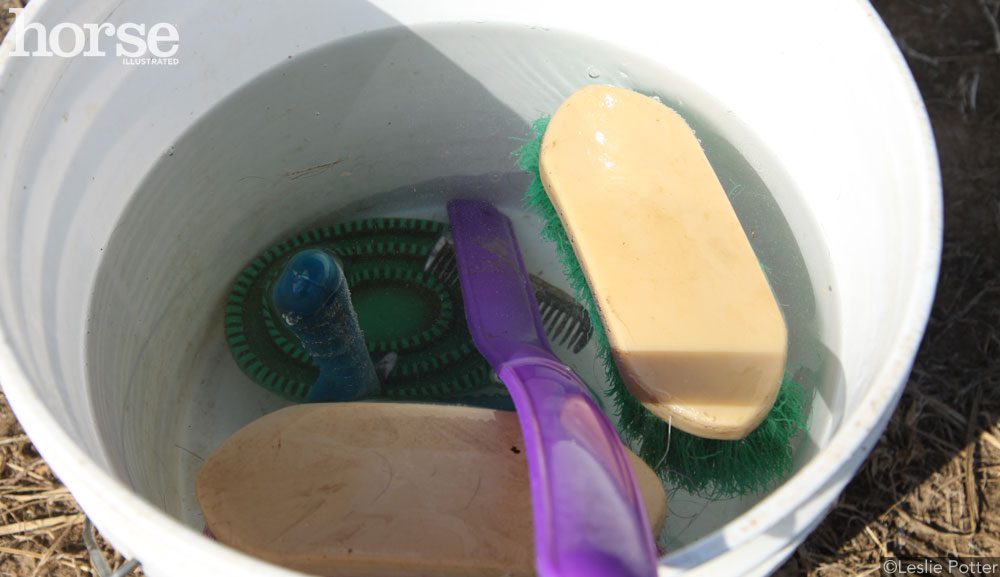
1. Wash your brushes regularly
Once a month or more (depending on how greasy your horse is), wash your brushes well with soap and water. Dirty and dusty brushes will not help you clean your horse well.
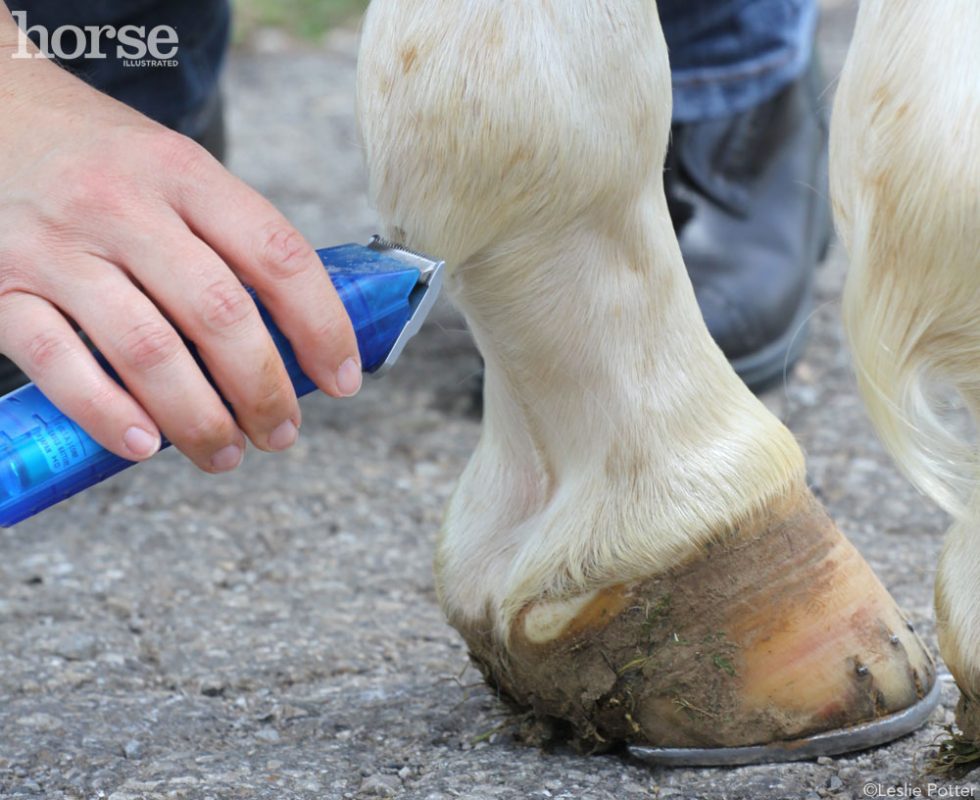
2. Trim the brushes on your legs
An unbrushed horse is bad, but dirty brushes are a more serious problem. If you cut the brushes, the dirt will not stick to them as much, and it will be easier to clean them. Clipped brushes are cleaner and drier, which can help prevent biting biting.
3. Train your horse to vacuum
Once horses get used to the noise of the vacuum cleaner, they begin to enjoy the process of cleaning, reminiscent of a relaxing massage. Be careful to stay away from sensitive areas. If in some area you do not use a rubber comb, it is also better not to approach it with a vacuum cleaner. Do not use it while cleaning the head and lower parts of the legs.
If you don’t want to spend money on one of the expensive horse vacuum cleaners, you can use a handheld vacuum cleaner.
For best results, go over the horse with a rubber comb to pick up dirt and dust that has stuck to the surface, and then use a vacuum cleaner. Finish off with a body brush, mist with a spray or coat conditioner.
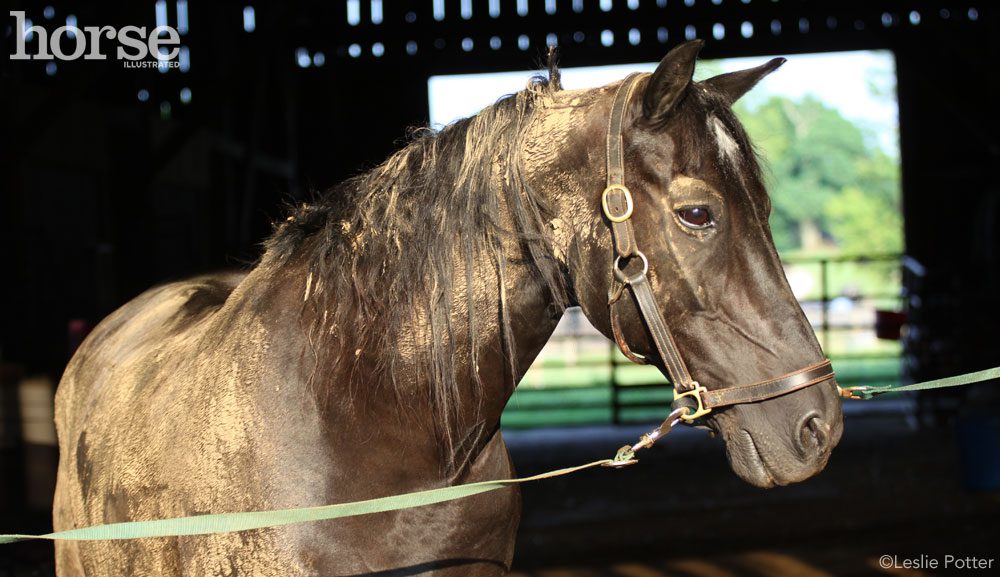
With the help of a scraper and a vacuum cleaner, dried, but not wet dirt can be removed.
4. Teach Your Horse How to Respond to the Dryer
A hair dryer can be useful in many cases. So, it is easier to remove dry dirt than wet dirt (wet feet or tail). The hair dryer is also useful for straightening the mane or tail, which were previously braided. Spray the mane with water and soak the tail in a bucket of water. Then use a brush and blow dryer to straighten your hair. Your horse’s mane and tail will flow like a river.
You can also use a hair dryer to dry a sweaty horse in winter. First of all, wipe sweaty areas with a towel to remove as much moisture as you can. Turn on the hair dryer on the cool air setting and hold it a few inches away and ruffle the coat with your fingers. Don’t stay in one place for too long. Move to another sweaty area, such as from the chest to the saddle area and back, so you don’t accidentally overheat your skin. This is not a substitute for proper cooling of the horse – you simply help dry the coat once the horse has cooled down.
Transfer Valeria Smirnova (sources 1 and 2).




